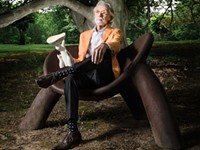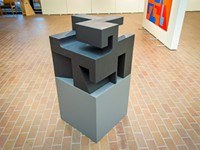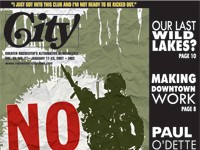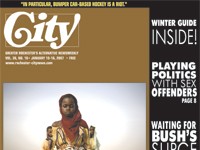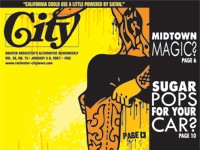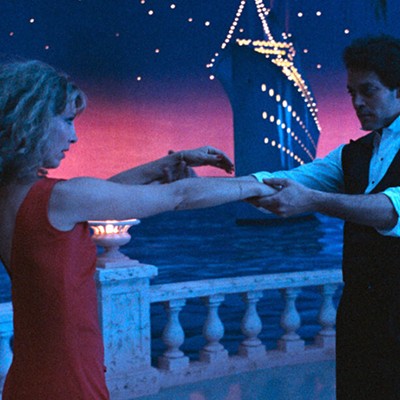[
{
"name": "500x250 Ad",
"insertPoint": "5",
"component": "15667920",
"parentWrapperClass": "",
"requiredCountToDisplay": "1"
}
]
It was an odd question, and I took a long moment to react.
There I was at the corner of Main and Gibbs, right under the Eastman Theatre marquee. A young woman came up and pointed to the Central YMCA across the street. How do you get into that building? she asked. Where's the entrance?
Huh? Is this for real? I thought. Then I saw the problem. You enter the Y from a platform, not straight in from the sidewalk. In certain light conditions, the entrance looks darkened, even obscure. The building also fools you with a kind of false entrance at the corner. Actually a multi-story set of windows, this "entrance" allows light but not people into the building.
Don't get me wrong: The Y is a solid and useful facility. And it's a lot more accessible than many old buildings. It's just that it represents a modern dilemma or duality. Today we have many public or semi-public buildings that are very open (for example, to people in wheelchairs) but still uninviting.
This duality was what brought me to Main and Gibbs in the first place.
Specifically, I was checking out Main Street's 21st century character, its pluses and minuses, its past and future. That was a bit of an overload, so I also took refuge in simple pleasures: The street's impressive visuals. The cohorts of tall buildings, with their angular relationships with the side streets. The feel of something not unlike the clichéd "mountain ranges" of Manhattan --- let's say, some decent "foothills" of brick, stone, and concrete.
The four compass points at Main and Gibbs encapsulate a special history, one that still informs Main Street as a whole. The Theatre, on the southeast corner, is a cultural, historic, and architectural anchor. The new Y, on the northeast corner, is a replacement for long-gone storefronts. (The original Y, located on Gibbs just behind those Main Street storefronts, was torn down years ago.) On the southwest corner, there's a pocket park right out of modern manuals about public space; and on the remaining corner, there's a large parking lot without a map to the future.
What will become of Main Street? In the Age of Wal-Mart, that's a general question that dogs American communities of all sizes.
These days in Rochester, however, anxieties about older commercial areas revolve around a single question, admittedly a big one: the Renaissance Square project, a complex that would put a bus terminal, performing-arts center, and office tower into one complex on East Main immediately west of Clinton. But what about the rest of Main within the central business district --- loosely the section within the Inner Loop, with some spillover on each end?
This length of street certainly has caught the attention of local architects and planners. And what's most attention-grabbing is the way Main Street's details work together as almost a unit.
Everyone knows, or should know, that Main Street has its share of great buildings: the old Sibley's department store (now housing college classrooms, etc., but no longer a DMV branch), the historic GraniteBuilding, the fireproof-pioneering PowersBuilding, and others. But how it all hangs together makes the differences.
Overall, Main Street "ranks high because it's reasonably intact," says Rochester architect Roger Brown. "It's long, straight, and linear" with "really wonderful space." Too many main thoroughfares in the country, says Brown, have had their street walls broken up with inappropriate development, most notoriously parking lots.
What we have today, says Brown --- whose firm, Barkstrom and LaCroix, has offices on Chestnut Street --- are two very different conceptions of "public realms." In suburban areas, he says, "buildings are just sort of scattered around," with "no sense of cohesiveness." In urban areas, relationships are what matter above all else. "It's so important how buildings relate to the street... how villages and cities create their identities, their life."
"In New York City," says Brown, "you walk down the streets; the first floors are loaded with activity, and the second floors have these wonderful windows." The combination, he says, just invites you in. He contrasts this very urban atmosphere with what Rochesterians see along South Avenue near Main, for example: a long bare wall of the RiversideConvention Center, and further down, the fortress-like first story of the Excellus Blue Cross Blue Shield headquarters.
"Whatever you do with buildings in the public realm, they have to be set up for pedestrian-related [uses]," says Brown. Such configurations, he says, draw people to older cities like Savannah, Georgia, and Charleston, South Carolina.
So what do we do about our own Main Street? How do we make it better?
Brown has some suggestions for upgrading parts of the street. He addresses, for example, the intact row of historic structures on West Main in the Cascade District. "I see those potentially as more residential in nature," he says. Residential construction might work nearby, as well, for example where the old Hotel Rochester stood until recently. The new development, he says, wouldn't have to be as tall as the old hotel or some surrounding structures. "Three or four stories could do the job," he says. He adds that "the incorporation of green space is very important" in making such new buildings and streetscapes attractive and livable.
He'd also like to see new means of travel. Chattanooga, he says, is just one city that's put in small electric buses to serve its main drag. "They ply up and down," he says --- something like Rochester's now-abandoned EZ Rider, but without the noise and exhaust.
Brown looks eastward from the Central Business District, as well. "Downtown," he says, is "where you concentrate more on office use and some residential," he says. Then "you cross the Inner Loop and concentrate on lower-scale commercial with residential." Planners could carry this down to the neighborhood around the Main Street Armory and the now-abandoned Eastman Dental Dispensary, says Brown. He views the Dental Dispensary as a prime candidate for residential redevelopment.
The behemoth down the street is another story. "I think it's hard when you have an armory that's so huge," says Brown. "It's glorious, but it's tough." But if residential construction were put around it, he says, the Armory might make a great indoor market, as in some other cities. (Compare Toronto's St. Lawrence Market, an enormous vertical and horizontal space containing a myriad of small semi-open shops.)
Brown says "a vision plan" must be drawn up for Main Street between the Inner Loop and the bridge near Goodman Street. The vision might start with bringing the Inner Loop up to grade, all the better to create "a residential gateway" to downtown. "You can't string it out; it's the concentrated areas that are the most successful ones," he says. "You need to always think about the building in relationship to the next building."
Jim Doukas --- who with his wife, Shelley, owns and operates the Penguin Restaurant on East Main near Alexander --- has his own thoughts about what the street could be.
He starts with the inevitable comparison: "It's a lot tougher than it used to be, even five or six years ago." He notes that the Dental Dispensary, just across from the Penguin, has been vacant for more than two decades. But other outfits have moved out more recently, he says, including a Blue Cross office quite near the restaurant.
Doukas and his wife live on GardinerPark, off Alexander and Union, an easy walk from the restaurant. He says his father, now retired, bought the Penguin in 1972 from the original owner, who'd opened it in the 1930s. The building, says Doukas, was built in 1908 or 1909; renovations came later.
What possibilities does a small independent businessperson see for this end of Main, now sprinkled with things like a busy car wash, a Wendy's, and closer to downtown, a KFC? (On the other hand, there's also an old home that long has housed WDKX radio.)
First, Doukas says he's not getting enough attention from City Hall. "It kind of sucks," he says. "All the money is going to Brown's Race and East Avenue. They paved [East Main] two years ago, but they kept it the same way."
This section of East Main suffers from a common bias, says Doukas: People say, "You go a block over and you're in the ghetto." Moreover, the street risked taking a hit from bad publicity after a tragic fatal late-night shooting a short time ago. But that well-publicized story didn't damage the street's reputation, says Doukas. In fact, he says, things are looking up in some ways. After a nearby gay-oriented restaurant stopped serving fish fries, he says, the Penguin took up the slack. "Our Friday nights, we have a big gay clientele," he says. The restaurant is generally busy on weekends, he says. Some of this is spillover from matinees at the Auditorium.
And there's diversity of all kinds. "We have a total mix, from one end to the other," says Doukas. "It's fun."
Over at City Hall, some Main Street projects --- on the conceptual level, at least --- are getting in gear.
For example, planners and stakeholders put together a Center City Master Plan last spring. The plan, part of the implementation phase of Rochester 2010: the Renaissance, lays down guidelines for downtown projects. It includes a strong statement that could apply to Main, especially: "Great cities are made from great streets."
One chapter, the "Center City Concept Plan," mentions or alludes to Main Street in several connections. It urges the "elimination of 'barriers' created by the Inner Loop Expressway" on the east side. It calls for development of a transit center along Main. (It doesn't specify a Renaissance Square-style combo, however. Note that alternative proposals exist; the most competitive one is a plan to put amenities for bus riders in the old Sibley's --- and keep the buses on the street.)
Significantly, the Concept Plan emphasizes "an enhanced pedestrian circulation system with new linkages [and] connections to the GeneseeRiver and to Main Street."
Larry Stid, the city's director of community development, says anything done along Main Street should fit with the character of Sibley's, the GraniteBuilding, and other major structures. He acknowledges that most existing projects within the Inner Loop are happening off, not on Main Street as such. But things are cooking very close by. Stid cites the residential conversion of the historic TempleBuilding near the Liberty Pole, as well as the renovation of the Stern building just north of Main Street. This kind of redevelopment could pay off in the Auditorium neighborhood, as well, he says.
Stid also points to near-Main residential developments such as the Gary Stern's conversion near Chevy Place and Christa Development's Sagamore, high-end condominiums nearing groundbreaking on East Avenue.
Stid hopes that a new federal transportation bill will provide money for transportation enhancements. He says other possibilities exist, too: heightened legal protection for significant buildings that don't yet have landmark status, for example. (Such protection could cover buildings like the DentalCenter, which as Stid says has faced the threat of demolition more than once.)
"Not having certainty has had somewhat of a dampening effect," Stid says.
Enter the new RochesterRegionalCommunityDesignCenter, which helps planners, architects, neighbors and other stakeholders preserve and rethink urban space, by hosting "design charrettes" on request.
Timothy Raymond, RRCDC board president, agrees that Main Street is "very urban" and "very intact," despite some breaks in the street wall. (One break he mentions is at the very center of things: the southwest corner of Main and Clinton, where the Chase Square building is set behind a plaza of sorts.)
"It's a classic Main Street," says Raymond. "You can't say anything's wrong with it," he says, apart from the problem of vacancies. "Some places are crying for development, like Main and Plymouth, where all four corners are vacant now." He says the RRCDC and others have recommended that Stone Street be extended north across Main. (That's right through the site of the proposed Renaissance Square; if the controversial project goes ahead, the extension could run through a covered arcade.)
The important point here, says Raymond, is to create more "access points" to Main Street while also developing greater densities.
Raymond believes the transit discussion should focus on improving service. He notes that County Executive Maggie Brooks recently mentioned a combination bus terminal and performing-arts center that's succeeded in downtown Dayton, Ohio. Indeed, as the Democrat and Chronicle reported last month, Brooks said the Dayton facility "spurred housing development" there.
But as Raymond says, the Dayton facility keeps its performing arts indoors, while leaving the buses on the street. That, he says, seems more like an alternative proposal for a bus station, which has been dismissed by the transit authority. That proposal would bring the bus riders into the old Sibley's, while keeping the vehicles outside.
Speaking of...
Latest in Featured story
More by Jack Bradigan Spula
-
School improvement: the price is wrought
Apr 7, 2004 -
Hour of power
Mar 31, 2004 -

As the windmill turns: residents doubt the power
Mar 24, 2004 - More »


